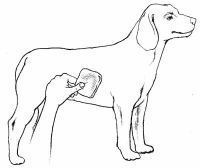How to Treat a Bleeding Dog
A dog's paws and legs are vulnerable to injury from broken glass, nails, and other sharp objects, and they will bleed heavily when cut. An injured ear will also bleed heavily because the skin over the ear is so thin.
With any bleeding injury, the main purpose of first aid is to prevent excessive blood loss, which can lead to shock. The signs of shock include pale or white gums, a rapid heartbeat, or rapid breathing. If any wound is spurting blood, it means an artery has been cut. This requires immediate professional attention.
Advertisement
How you tend to your dog will depend on the location and extent of the bleeding. The following dog care tips will help you apply first aid to various body areas.
Dog's Bleeding Head or Torso
Step 1: Restrain the dog if necessary.
Step 1a: Approach the dog slowly, speaking in a reassuring tone of voice.
Step 1b: Slip a leash around the dog's neck, then place the leash around a fixed object. Pull the dog against this object and tie the leash so the dog cannot move its head.
Step 1c: Muzzle the dog to protect yourself.
Step 2: Cover the wound with a sterile gauze pad, clean folded towel, or sanitary napkin.
Step 3: Wrap torn rags or other soft material around the dressing and tie or tape it just tightly enough to hold the bandage in place.
Step 4: Transport the dog immediately to the veterinarian.
Dog's Bleeding Leg, Paw, or Tail
Step 1: Restrain the dog if necessary.

Step 1a: Approach the dog slowly, speaking in a reassuring tone of voice.
Step 2: Clip the hair around the injured area.
Step 3: Examine the wound for glass or other foreign objects. If visible, remove the object with your fingers or a pair of tweezers. If the tissue under the wound appears to pass by when you move the skin, the wound will probably require stitches.
Step 4: Flush the wound thoroughly with clean water. Avoid home antiseptics, which may cause pain when applied.
Step 5: Cover the wound with a clean cloth, sterile dressing, or sanitary napkin.
Step 6: Place your hand over the dressing and press firmly.

Step 7: Keep pressure on the dressing to stop bleeding. If blood soaks through the dressing, DO NOT remove it. Apply more dressing and continue to apply pressure until the bleeding stops. If the bleeding does not stop within 5 minutes, continue to apply pressure on the wound while transporting the dog to the veterinarian.
Step 8: Wrap torn rags or other soft material around the dressing and tie or tape it just tightly enough to keep the bandage on. Start below the wound and wrap upward.
Step 9: If the wound is deep enough to require stitches, keep the dog off the injured leg, and immediately transport your pet to the veterinarian.
Dog's Bleeding Chest or Abdomen
Step 1: Restrain the dog if necessary.
Step 1a: Approach the dog slowly, speaking in a reassuring tone of voice.
Step 1b: Muzzle the dog to protect yourself.
Step 2: If the wound is in the chest and a "sucking" noise is heard, bandage the wound tightly enough to keep air from entering, and transport the dog immediately to the veterinarian. If not, proceed to Step 3.
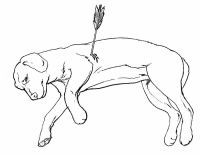
Step 3: If there is a protruding object, such as an arrow, DO NOT attempt to remove the object. If not, proceed to Step 4.
Step 3a: Place clean cloths, sterile dressings, or sanitary napkins around the point of entry.
Step 3b: Bandage tightly around the point of entry.
Step 3c: Transport the dog immediately to the veterinarian.
Step 4: Clip the hair around the injured area.
Step 5: Examine the wound for glass or other foreign objects. If visible, remove the object with your fingers or a pair of tweezers. If the tissue under the wound appears to pass by when you move the skin, the wound will probably require stitches.
Step 6: Flush the wound thoroughly with clean water.
Step 7: Cover the wound with a clean cloth, sterile dressing, or sanitary napkin.
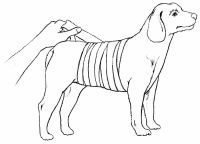
Step 8: Place your hand over the dressing and press firmly.
Step 9: Keep pressure on the dressing to stop the bleeding. If blood soaks through the dressing, DO NOT remove it. Apply more dressing and continue to apply pressure until the bleeding stops.
Step 10: Wrap torn sheets or other soft material around the dressing and tie or tape it just tightly enough to keep the bandage on.
Step 11: If the wound is deep enough to require stitches, transport the dog immediately to the veterinarian.
Dog's Bleeding Ear
Step 1: Restrain the dog if necessary.
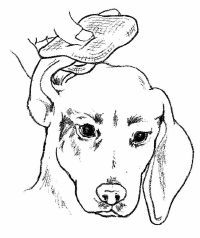
Step 1a: Approach the dog slowly, speaking in a reassuring tone of voice.
Step 1b: Muzzle the dog to protect yourself.
Step 2: Cover the wound with a clean cloth, sterile dressing, or sanitary napkin. Place dressing material on both sides of the ear flap, then fold it over the top of the dog's head and hold firmly to control bleeding.
Step 3: Wrap torn sheets or rags around the dressing, ear, and head, making sure the entire ear is covered. Tape or tie the bandage in place.
Step 4: Transport the dog immediately to the veterinarian.
Dog's Bleeding Nails
A broken nail or one that is cut too short are the most common reasons for a bleeding nail. Be sure to bring your dog to the groomer if you're not comfortable clipping its nails.
If the nail is broken:
Step 1: Restrain the dog if necessary.
Step 1a: Approach the dog slowly, speaking in a reassuring tone of voice.
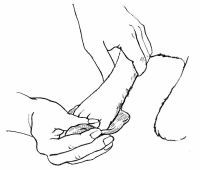
Step 2: DO NOT try to cut or remove the broken nail without muzzling the dog.
Step 3: Hold a clean cloth, sterile dressing, or sanitary napkin against the nail. The bleeding will stop in a few minutes.
Step 4: Transport the dog to the veterinarian as soon as possible.
If the nail is cut too short:
Step 1: Restrain the dog if necessary.
Step 1a: Approach the dog slowly, speaking in a reassuring tone of voice.
Step 1b: Slip a leash around the dog's neck, then place the leash around a fixed object. Pull the dog against this object and tie the leash so the dog cannot move its head.
Step 1c: Muzzle the dog to protect yourself.
Step 2: Hold a clean cloth, sterile dressing, or sanitary napkin against the nail.
Step 3: Keep firm pressure on the area for at least 5 minutes. DO NOT remove the bandage until the bleeding stops.
Step 4: If the bleeding does not stop in 15 to 20 minutes, transport the dog to the veterinarian as soon as possible. Continuous bleeding indicates a bleeding disorder that should be treated promptly.
Internal Bleeding
Internal bleeding is always an emergency. The signs of internal bleeding are pale or white gums; rapid heartbeat or breathing; and bleeding from the ears, nose, mouth, or rectum. The following steps will help you treat the dog for any potential shock, and transport the dog to professional help immediately.
Step 1: If there is bleeding from any external wounds, treat for shock.
Step 1a: Examine the gums by gently lifting the upper lip so the gum is visible. Pale or white gums indicate the dog is almost certainly in shock and may have serious internal injuries and/or bleeding. If the gums are pink, the dog is probably not in shock.
Step 1b: Determine the heartbeat. Place your fingers firmly on the dog about 2 inches behind the dog's elbow in the center of its chest. Count the number of beats in 10 seconds and multiply by 6. If the dog is in shock its heartbeat may be more than 150 beats per minute.

Step 2: Place the dog on its side with its head extended.
Step 3: Gently pull out the dog's tongue to keep the airway open.
Step 4: Elevate the dog's hindquarters slightly by placing them on a pillow or folded towels.
Step 5: To conserve body heat, wrap the dog in a blanket or jacket.
Step 6: Transport the dog immediately to the veterinarian.
Bloating is a serious condition that can cause sudden death to a dog. In the next section, we'll discuss the signs of bloating and what to do if you suspect your pet is suffering from it.
